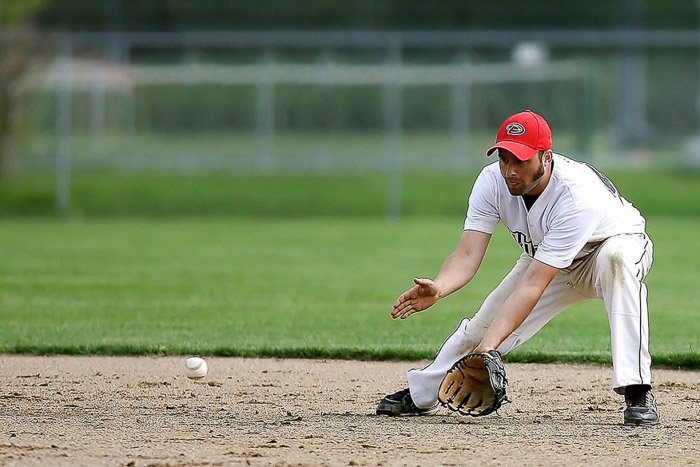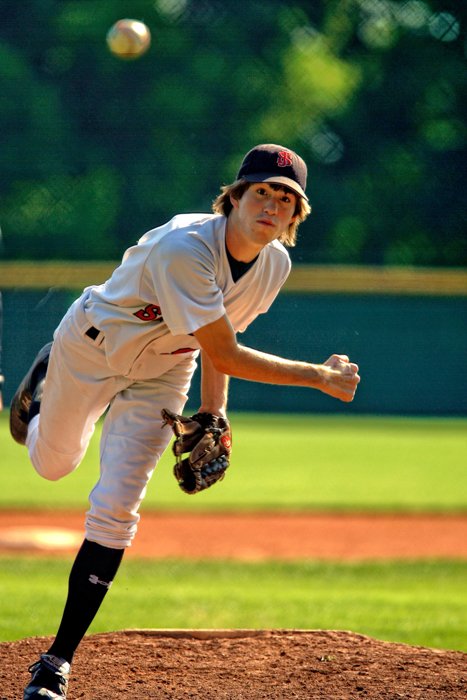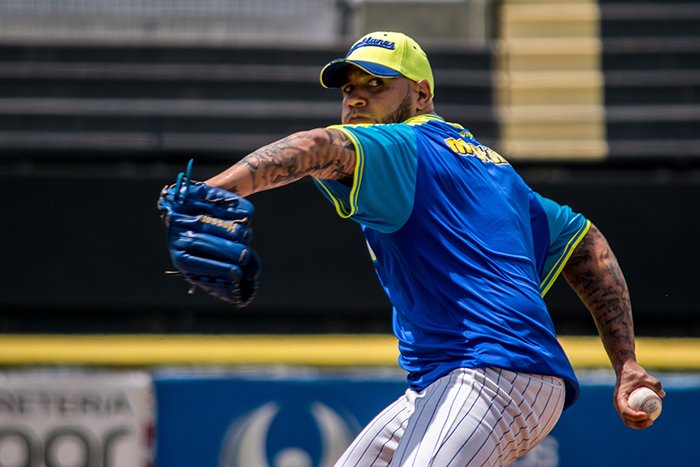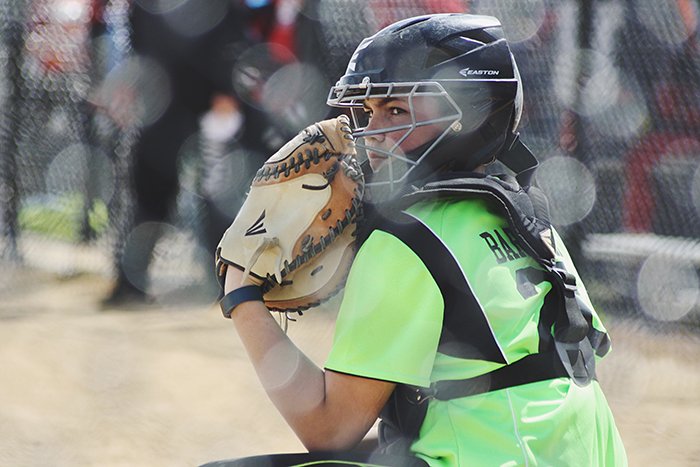To get the best shots of the ball game, you’ll need a mix of the right camera settings, the ability to anticipate the play, and some compositional tips. Most baseball and softball games offer plenty of opportunities to practice and hundreds of chances to get a great shot. Before you head out to the game, put these softball and baseball photography tips into use. They’ll increase your odds of getting a great shot.
7. Baseball Photography: 7 Best Photography Spots on the Field
Perspective in baseball photography can mean the difference between that great shot that shows the height of the action — and a shot obstructed by a chain-link fence. Before the game starts, find a spot that’s safe to stand in. And allows you to see a majority of the action. Look for a view of at least home plate and first base. Your location should allow you to capture the players’ faces, not their backs. Where you can stand will depend on what league you are photographing and what field you are shooting on. When I photographed high school baseball for the local newspaper, I would talk to the referee ahead of time. Often, the official would allow me to stand inside the fence in a designated area between home plate and first base. This was outside the play and well beyond the foul line. During my son’s t-ball games, I would stand in the opening of the dugout. It’s great for pictures and volunteering to organize the batters. You may not have a press pass, a willing official, or a league lenient enough. Arrive early enough to scout out a location that’s free of obstructions like chain link fences. Shooting from the stands is fine too. But you might need an even longer lens to get close to the action.
6. Use a Fast Shutter Speed
Like all sports photography, shutter speed is the most important exposure setting to master in baseball photography. The shutter speed needs to be fast enough to freeze the motion no matter what sport you are photographing. The pitcher winding up that curveball and the batter sending it to the outfield all happens very quickly. Shoot in shutter priority mode (or full manual mode if you are comfortable there). Set the shutter speed at around 1/500, to begin with. If it’s a bright sunny day, you can push that up even higher. If the game is at dusk, you may need to push the shutter a little slower. To get that fast shutter speed, you will likely need to use a higher ISO. Many modern digital cameras can shoot to ISO 1600, ISO 3200 and even beyond with little degradation to image quality. Knowing your gear helps you determine how high you can push that ISO without serious loss in image quality. The best exposure settings for baseball and softball photography will have a shutter speed high enough to eliminate blur and an ISO that’s low enough not to introduce crazy noise and degradation. On most modern cameras, that’s a fairly flexible range, particularly for a daytime game.
5. Use Burst Mode to Increase Your Chances of Capturing a Great Image
Snapping a photo at the moment the bat hits the ball is about as hard as actually hitting that pitch yourself. To increase the odds of capturing that moment, turn on your camera’s burst mode. Instead of taking a single photo, burst mode will capture several images in a row. Activating burst mode varies a bit based on the model camera that you have. The setting can often be found as a physical shortcut on some DSLRs and mirrorless cameras. Check for an icon that looks like three rectangles layered on top of each other. Some cameras put the feature inside the same set of controls as the self-timer. This is designated by a timer symbol. Other cameras hide the feature in the menu. If you’ve looked through the physical controls and menu and can’t find the burst mode, consult your camera’s user manual. Using burst mode is almost identical to shooting a single photo. But after pressing the shutter button, you’ll keep pressing the button until you’d like the burst to stop. You should still be cautious when using burst mode, or you’ll fill up the memory card very quickly. Some cameras need a few seconds to finish recording those files before starting another burst. Keep that in mind as well. High-end cameras can often keep up with fast bursts while shooting RAW. If you are using a budget camera, you may want to see if shooting JPEG increases the camera’s performance in burst mode.
4. Set the Autofocus to Continuous and Single Point
In sports photography, continuous autofocus is ideal for getting sharply focused images. In this mode, the camera will continue focusing even after the shutter button is pressed halfway. This increases the odds of getting a sharp moving subject. On most camera models like Nikon and Sony, this mode is called continuous autofocus or AF-C. Canon calls the same setting Al Servo or AF. Most DSLRs and mirrorless cameras will have the setting as a shortcut on a physical control for easy switching. In some cameras, the option is inside the quick menu or the full menu. Some cameras will slow the burst speed in continuous autofocus mode. You may need to use the slower burst mode for this option. Along with the continuous autofocus, switching to single-point autofocus mode will help make sure the camera focuses where you want the focus of the image to be. In this mode, you’ll use the joystick or the arrow keys to move the focus point around to different parts of the image. In baseball and softball, it’s generally pretty easy to anticipate what part of the frame you’ll want to place the subject in. Using this mode helps you focus on a specific player when multiple athletes are in the frame.
3. Zoom in Close
Most of the detail that makes a great softball or baseball photo can’t be seen from a wide-angle lens. Use a telephoto zoom lens to get up close to the action. You can get close enough to see the expression in the players’ faces. A 70-300mm lens is good if you can position yourself close to the field. If you need to stand farther away, you may need more zoom. Composition in softball and baseball photography is a balance between getting close enough to see that expression, and far enough away to see what’s going on in the play. If an opponent is coming to tag that base runner, back up the composition a bit to show both players. When composing for softball and baseball photography, leave the most empty space in the direction that the player or ball is heading. This will lead the viewer’s eye through the frame. Leaving empty space behind the player often creates an image that’s not as strong. And it can cause you to miss the moment.
2. How to Anticipate Great Shots During Games
If you wait until the play happens to pick up your camera, point it in the right direction, and focus — you’ve already missed the moment. In any form of sports photography, anticipation is key. Part of that is understanding the game. Do you know the signs for when a runner is about to steal a base? Do you know where the outfielder will likely throw the ball to? If this is your first time at a baseball or softball game, watch a few games or read up on the sport. It’ll help you expect what’s going to happen when. When the ball is in play, keep the camera up to your eye and anticipate the action. Baseball and softball have plenty of downtime and milliseconds of the biggest moments. Be ready for the action when it happens. Try to keep track of which bases have runners on them and which are empty. This will help you determine where the ball will be thrown to. Baseball and softball have a few key moments that you should look for. Try capturing the batter hitting the ball. It’s a tricky shot, but you’ll have plenty of opportunities to get a well-timed image. Watch first base for a slide or tag. Photograph the pitcher in action. This is another one that you’ll have plenty of chances to grab. Then, watch for action in the outfield and infield.
1. Keep Your Eye on the Ball — and the Faces
In any sport involving a ball, the best shots are the ones with the ball in it. If the ball isn’t in the photo, it’s difficult for the viewer to make out what’s going on. In general, focus on capturing the action that involves the ball. A player safely running to the base while the ball is a good distance away isn’t nearly as exciting as running to a base with a potential out close by. Close-ups are good. But avoid cropping too close or you’ll get the action without the ball. Getting the ball in every single shot isn’t a hard and fast rule. But it should be in most shots. An image of players celebrating a good play, for example, is a great shot that won’t have the ball in it. Along with looking for the ball, you should have the athlete’s face in the image instead of their back. Part of that is in where you stand on the field. If you stand near first base, you’ll get most batters’ faces except for the lefties.
Conclusion: Street Photography Quotes
In sports photography, most of your shots will be throwaways while a handful will be keepers. That’s normal. No one can anticipate the action and be in the right place for the shot 100 per cent of the time. Not even the professionals. The average ball game will offer plenty of chances to capture a good shot if you put a handful of baseball photography tips into action. With the right settings, composition tips, and some anticipation and practice, you’ll capture great shots of the game. For more great sports photography tips, check our posts on shooting basketball photography or swimming pictures!






title: “7 Secrets For Better Softball And Baseball Photography” ShowToc: true date: “2023-02-07” author: “Bill Martinez”
To get the best shots of the ball game, you’ll need a mix of the right camera settings, the ability to anticipate the play, and some compositional tips. Most baseball and softball games offer plenty of opportunities to practice and hundreds of chances to get a great shot. Before you head out to the game, put these softball and baseball photography tips into use. They’ll increase your odds of getting a great shot.
7. Baseball Photography: 7 Best Photography Spots on the Field
Perspective in baseball photography can mean the difference between that great shot that shows the height of the action — and a shot obstructed by a chain-link fence. Before the game starts, find a spot that’s safe to stand in. And allows you to see a majority of the action. Look for a view of at least home plate and first base. Your location should allow you to capture the players’ faces, not their backs. Where you can stand will depend on what league you are photographing and what field you are shooting on. When I photographed high school baseball for the local newspaper, I would talk to the referee ahead of time. Often, the official would allow me to stand inside the fence in a designated area between home plate and first base. This was outside the play and well beyond the foul line. During my son’s t-ball games, I would stand in the opening of the dugout. It’s great for pictures and volunteering to organize the batters. You may not have a press pass, a willing official, or a league lenient enough. Arrive early enough to scout out a location that’s free of obstructions like chain link fences. Shooting from the stands is fine too. But you might need an even longer lens to get close to the action.
6. Use a Fast Shutter Speed
Like all sports photography, shutter speed is the most important exposure setting to master in baseball photography. The shutter speed needs to be fast enough to freeze the motion no matter what sport you are photographing. The pitcher winding up that curveball and the batter sending it to the outfield all happens very quickly. Shoot in shutter priority mode (or full manual mode if you are comfortable there). Set the shutter speed at around 1/500, to begin with. If it’s a bright sunny day, you can push that up even higher. If the game is at dusk, you may need to push the shutter a little slower. To get that fast shutter speed, you will likely need to use a higher ISO. Many modern digital cameras can shoot to ISO 1600, ISO 3200 and even beyond with little degradation to image quality. Knowing your gear helps you determine how high you can push that ISO without serious loss in image quality. The best exposure settings for baseball and softball photography will have a shutter speed high enough to eliminate blur and an ISO that’s low enough not to introduce crazy noise and degradation. On most modern cameras, that’s a fairly flexible range, particularly for a daytime game.
5. Use Burst Mode to Increase Your Chances of Capturing a Great Image
Snapping a photo at the moment the bat hits the ball is about as hard as actually hitting that pitch yourself. To increase the odds of capturing that moment, turn on your camera’s burst mode. Instead of taking a single photo, burst mode will capture several images in a row. Activating burst mode varies a bit based on the model camera that you have. The setting can often be found as a physical shortcut on some DSLRs and mirrorless cameras. Check for an icon that looks like three rectangles layered on top of each other. Some cameras put the feature inside the same set of controls as the self-timer. This is designated by a timer symbol. Other cameras hide the feature in the menu. If you’ve looked through the physical controls and menu and can’t find the burst mode, consult your camera’s user manual. Using burst mode is almost identical to shooting a single photo. But after pressing the shutter button, you’ll keep pressing the button until you’d like the burst to stop. You should still be cautious when using burst mode, or you’ll fill up the memory card very quickly. Some cameras need a few seconds to finish recording those files before starting another burst. Keep that in mind as well. High-end cameras can often keep up with fast bursts while shooting RAW. If you are using a budget camera, you may want to see if shooting JPEG increases the camera’s performance in burst mode.
4. Set the Autofocus to Continuous and Single Point
In sports photography, continuous autofocus is ideal for getting sharply focused images. In this mode, the camera will continue focusing even after the shutter button is pressed halfway. This increases the odds of getting a sharp moving subject. On most camera models like Nikon and Sony, this mode is called continuous autofocus or AF-C. Canon calls the same setting Al Servo or AF. Most DSLRs and mirrorless cameras will have the setting as a shortcut on a physical control for easy switching. In some cameras, the option is inside the quick menu or the full menu. Some cameras will slow the burst speed in continuous autofocus mode. You may need to use the slower burst mode for this option. Along with the continuous autofocus, switching to single-point autofocus mode will help make sure the camera focuses where you want the focus of the image to be. In this mode, you’ll use the joystick or the arrow keys to move the focus point around to different parts of the image. In baseball and softball, it’s generally pretty easy to anticipate what part of the frame you’ll want to place the subject in. Using this mode helps you focus on a specific player when multiple athletes are in the frame.
3. Zoom in Close
Most of the detail that makes a great softball or baseball photo can’t be seen from a wide-angle lens. Use a telephoto zoom lens to get up close to the action. You can get close enough to see the expression in the players’ faces. A 70-300mm lens is good if you can position yourself close to the field. If you need to stand farther away, you may need more zoom. Composition in softball and baseball photography is a balance between getting close enough to see that expression, and far enough away to see what’s going on in the play. If an opponent is coming to tag that base runner, back up the composition a bit to show both players. When composing for softball and baseball photography, leave the most empty space in the direction that the player or ball is heading. This will lead the viewer’s eye through the frame. Leaving empty space behind the player often creates an image that’s not as strong. And it can cause you to miss the moment.
2. How to Anticipate Great Shots During Games
If you wait until the play happens to pick up your camera, point it in the right direction, and focus — you’ve already missed the moment. In any form of sports photography, anticipation is key. Part of that is understanding the game. Do you know the signs for when a runner is about to steal a base? Do you know where the outfielder will likely throw the ball to? If this is your first time at a baseball or softball game, watch a few games or read up on the sport. It’ll help you expect what’s going to happen when. When the ball is in play, keep the camera up to your eye and anticipate the action. Baseball and softball have plenty of downtime and milliseconds of the biggest moments. Be ready for the action when it happens. Try to keep track of which bases have runners on them and which are empty. This will help you determine where the ball will be thrown to. Baseball and softball have a few key moments that you should look for. Try capturing the batter hitting the ball. It’s a tricky shot, but you’ll have plenty of opportunities to get a well-timed image. Watch first base for a slide or tag. Photograph the pitcher in action. This is another one that you’ll have plenty of chances to grab. Then, watch for action in the outfield and infield.
1. Keep Your Eye on the Ball — and the Faces
In any sport involving a ball, the best shots are the ones with the ball in it. If the ball isn’t in the photo, it’s difficult for the viewer to make out what’s going on. In general, focus on capturing the action that involves the ball. A player safely running to the base while the ball is a good distance away isn’t nearly as exciting as running to a base with a potential out close by. Close-ups are good. But avoid cropping too close or you’ll get the action without the ball. Getting the ball in every single shot isn’t a hard and fast rule. But it should be in most shots. An image of players celebrating a good play, for example, is a great shot that won’t have the ball in it. Along with looking for the ball, you should have the athlete’s face in the image instead of their back. Part of that is in where you stand on the field. If you stand near first base, you’ll get most batters’ faces except for the lefties.
Conclusion: Street Photography Quotes
In sports photography, most of your shots will be throwaways while a handful will be keepers. That’s normal. No one can anticipate the action and be in the right place for the shot 100 per cent of the time. Not even the professionals. The average ball game will offer plenty of chances to capture a good shot if you put a handful of baseball photography tips into action. With the right settings, composition tips, and some anticipation and practice, you’ll capture great shots of the game. For more great sports photography tips, check our posts on shooting basketball photography or swimming pictures!





